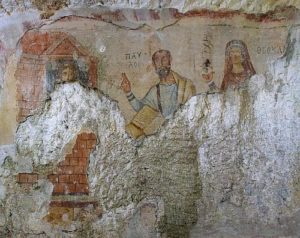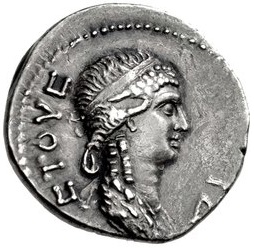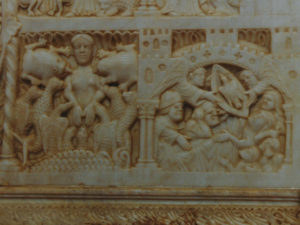Saint Thecla the Evangelist
A healthy number of saints’ stories feature people who were “called to chastity” or to a relationship with Christ vs. marriage. All kinds of fantastic legends and tales ensued about the lengths to which these people would go to avoid marriage and connubial sex. Ultimately, they were all successful in their quest to avoid sex with members of the opposite sex. They ended up living alone (rarely) or with a same-sex companion (often) or same-sex community in a wilderness setting (usually).
St. Thecla the Evangelist is one of those saints. She would face anything but marriage.
Thecla’s story is preserved in the Acts of Paul and Thecla, an apocryphal story of Paul’s impact on a young virgin, Thecla, and her subsequent trials, adventures and spiritual leadership as his disciple. She infuriated many Church Fathers, including Tertullian, who griped that some Christians were using the example of Thecla to legitimize women’s roles in teaching and baptizing.
According to Acts, Thecla was a beautiful young woman of Iconium (now Konya, Turkey) whose life was transformed when she heard St. Paul preaching in the street beneath her window. She announced her intention to break off her engagement and to embrace a life of chastity. Her finance was furious. Her family was scandalized. They denounced her to the governor who had her arrested and condemned to death. Thecla was tied naked to a stake, but a miraculous thunderstorm put out the flames. She is saved. Once home, Thecla disguises herself as a youth and escapes to reunite with Paul and travel to Antioch.
While traveling, she is sexually assaulted by Alexander, a prominent man of Antioch. One account reads: “Repulsing the assault, she tears his cloak and knocks the wreath from his head. Alexander (the would-be ravisher) brings her before the magistrate who, despite the protests of the women of the city, again condemns Thecla to death, this time ad bestias. Pleading to remain a virgin until her death, she is taken in by ‘a certain rich queen, Tryphaena by name,” who lost her own daughter. (Tryphaena was the widow of Cotys, King of Thrace and a great-niece of the Emperor Claudius. In Romans 16:12, Paul sends greetings to a Tryphaena.)
Thecla is allowed to return to Tryshaena. She rides a lioness (who licks her feet) and is paraded through the city. The next morning, Alexander comes for her and escorts her to the arena to die. There she is stripped and thrown to wild beasts. A lioness (presumably the one who licked her feet) protects her from the attacks of lions, bulls and bears. Thecla prays, and throws herself into a trench of water (an euripus) and baptizes herself. The water is full of ferocious and hungry seals. A cloud of fire covers her nakedness and kills the vicious seals. The women in the stands of the arena cast fragrant nard and balsam into the area, which had a pacifying effect on the remaining wild animals. The awestruck governor releases Thecla and she returns to the palace of Queen Tryshaena. Refusing all entreaties to stay with the queen, Thecla dresses in male clothing and sets out to find Paul. She tells him that she baptized herself, and had been commissioned by Christ to baptize and preach in his name. According to the story, Paul recognized her as a fellow apostle and encouraged her to preach the Gospel. Wherever she went, “a bright cloud conducted her on her journey.”
Thecla encouraged women to live a life of chastity and to follow the word of God. She returned home to find her finance had died and her mother indifferent to her preaching. She left, and in one version of her story, she dwelt in a cave in Seleucia Cilicia (southern Turkey) for 72 years and formed a monastic community of women, whose members she instructed “in the oracles of God.”
In another version, Thecla passed the rest of her life in a rocky desert cave in the mountains near the town of Ma’aloula (Syria). She became a healer and performed many miracles. She remained persecuted, and men still conspired to rape and kill her. Just as she was about to be seized, Thecla cried out to God for help. A fissure opened in the stone walls of her cave and she disappeared. It is said that she went to Rome and lay down beside Paul’s tomb.
Her cave became an important pilgrimage site in early and medieval Christianity. Today visitors can still see Thecla’s cave and the spring that provided water for her. The nuns who live at the Mar Thecla monastery will tell you her story and show you the opening in the rock where the saint escaped.
There are many wonderful parts of St. Thecla’s story, beginning with her determination to live her life following her calling to evangelize, rather than accede to family or societal expectations. Her protection by animals, the public affirmation by groups of women, are also very positive. She was unashamed of her nakedness when she was led twice to the arena to die. She was proud of her body, her virginity, and her sole possession of it. The biggest surprise was her encouragement by St. Paul ( wives-be-subordinate-to-your-husbands), accepting her as a fellow apostle. The ugly, horrifying constant throughout her life is the desire by men to rape Thecla or kill her if she won’t submit to their authority. Men who are rapists do not believe that they are the problem–females (or males) who aroused them are at fault. What can Christianity do to change this perception?



